Nikola Tesla and Thomas Edison are two giants of electrical engineering whose inventions changed history. But the electricity between the two is no secret to the world.
Let us begin with a simple question – who invented the lightbulb? Was your answer Edison? In my middle school, I learned that Thomas Alva Edison was the ultimate inventor with over 1000 patents, including the incandescent lightbulb and the phonograph, but the books failed to mention that he isn’t all what he’s claimed to be.

It should be noted that Edison purchased the patent from Henry Woodward and Matthew Evens in 1880, and then he hired a team to help him perfect this patent.
After perfecting this invention, the next thing was to commercialize it. Edison was not just an inventor but also a businessman. He once quoted, “Anything that won’t sell, I don’t want to invent. Its sale is the proof of utility and utility is success”. The next step would have been to plan a distribution system (remember the functioning lightbulb just came into existence). However, to commercialize it, one must also lay down plans for electrical systems. Edison came up with his DC distribution system – safe, simple and easy to install and connect to different towers. One major downside was its inability to provide efficient power outside a radius of a mile.
Edison wasn’t the only genius trying to solve the problem of electricity. There was also Nikola Tesla, a Serbian-America inventor, electrical engineer, mechanical engineer, and futurist, best known for his contributions to the design of the modern alternating current (AC) electricity supply system. He emigrated in 1884 to the United States, where he would become a naturalized citizen. He worked for a short time at the Edison Machine Works in New York City. He had to start working at the lowest levels in Edison’s company to prove his worth just because he was an outsider. Tesla stayed most of the time in the company coming up with ways to make others’ lives better. He believed that Edison’s DC distribution system was very inefficient and wanted to use AC. When he suggested this to Edison, he refused to listen and instead challenged Tesla to come up with a way to improve his current system and that he would be awarded a bonus of $50,000 when he did. Tesla not only found the problem but came up with various solutions for the same. And when asked for the reward money, Edison laughed saying he had joked about the money, and informed him that it was Tesla who failed to understand the American humour, reminding him about being an outsider in a foreign land. Edison instead offered a $10 raise. After being humiliated in such a way, Tesla quit Edison’s company.
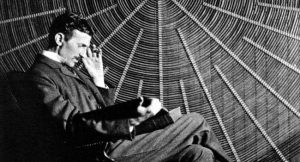
Without a job, Tesla had to work several jobs just to feed himself and the next few years were very difficult for him. He had to work at various electrical repair jobs and as a ditch digger for $2 per day. Later in life, Tesla would recount that part of 1886 as a time of hardship, writing “My high education in various branches of science, mechanics, and literature seemed to me like a mockery.” He even worked digging trenches that lay the groundwork for Edison’s distribution towers. But he never accepted that his AC distribution system was inferior to Edison’s.
In 1886 Nikola Tesla tried to sell his AC power system to investors in New York City, but it failed to be of interest in a city that is already heavily invested in DC power systems. Other inventors around the world also promoting AC power had similar problems.
Later in May ‘88, Tesla stood before the AIEE showcasing his polyphase motor. Engineers working for the Westinghouse Electric & Manufacturing Company reported to George Westinghouse that Tesla had a viable AC motor and related power system—something Westinghouse needed for the alternating current system he was already marketing.
Westinghouse had earlier looked into getting a patent on a similar commutator-less, rotating magnetic field-based induction motor developed in 1885 and presented in a paper in March 1888 by Italian physicist Galileo Ferraris, but decided that Tesla’s patent would probably control the market.
Tesla met George Westinghouse and convinced him that his AC system was superior to Edison’s. The next technical hurdle was the high voltage needed to power large machines which can be deadly, so alternating current is great but you have to work out all of the insulation and all of the safety devices because a hundred thousand volts will kill you. To solve the problem, Tesla looked at a new device developed by European engineers called a transformer which can step down the voltage from a hundred thousand volts to 110 volts.
Electrical power is the product of voltage and current, P= V x I. After generation, if the voltage is stepped up 20 times, to deliver the same power the current reduces 20 times. The power loss during transmission is proportional to current squared. So, effective power loss decreases 400 times. Then, the voltage may be stepped down for consumer use. This was only possible for AC and not DC. It should be noted that Tesla wasn’t the one who invented AC. Alternating current was developed in principle by Michael Faraday, and in practice by Hippolyte Pixii in the early 19th century. Practical devices employing AC in the medical world were developed before Tesla was even born. Contemporaries of Tesla working for George Westinghouse developed practical methods of distributing AC power from power plants before Tesla came to work for Westinghouse. Tesla himself studied the use of AC in college.
In July 1888, Alfred S. Brown and Charles F. Peck negotiated a licensing deal with George Westinghouse for Tesla’s polyphase induction motor and transformer designs for $60,000 in cash and stock and a royalty of $2.50 per AC horsepower produced by each motor. Westinghouse also hired Tesla for one year for the large fee of $2,000 ($55,800 in today’s dollars) per month to be a consultant at the Westinghouse Electric & Manufacturing Company’s Pittsburgh labs.

Two years after signing the Tesla contract, Westinghouse Electric was in trouble. The near collapse of Barings Bank in London triggered the financial panic of 1890, causing investors to call in their loans to W.E (Westinghouse Electric). The sudden cash shortage forced the company to refinance its debts. The new lenders demanded that Westinghouse cut back on what looked like excessive spending on acquisition of other companies, research, and patents, including the per motor royalty in the Tesla contract.
At that point, the Tesla induction motor had been unsuccessful and was stuck in development. Westinghouse was paying a $15,000-a-year guaranteed royalty even though operating examples of the motor were rare and the polyphase power systems needed to run it were even rarer. In early 1891, George Westinghouse explained his financial difficulties to Tesla in stark terms, telling him that if he did not meet the demands of his lenders, he would no longer be in control of Westinghouse Electric and Tesla would have to “deal with the bankers” to try to collect future royalties. The advantages of having Westinghouse continue to champion the motor probably seemed obvious to Tesla and he agreed to release the company from the royalty payment clause in the contract. Six years later Westinghouse would purchase Tesla’s patent for a lump sum payment of $216,000 as part of a patent-sharing agreement signed with General Electric (a company created from the 1892 merger of Edison and Thomson-Houston).
Seeing everyone favouring AC over his DC, Edison started playing dirty. Among a lot of people who opposed AC, there was one guy named Harold Brown. Determined to prove alternating current was more dangerous than direct current, he contacted Thomas Edison to see if he could make use of his equipment to conduct experiments. Edison immediately offered to assist Brown in his crusade against AC companies.
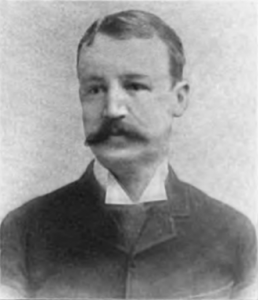
The Edison company and Brown colluded further in their parallel goals to limit the use of AC with attempts to push through legislation to severely limit AC installations and voltages. Before long, Brown was loaned space and equipment at Edison’s West Orange, New Jersey laboratory, as well as a laboratory assistant, Arthur Kennelly.
Brown paid local children to collect stray dogs off the street for his experiments with direct and alternating current. After much experimentation which resulted in the killing of a series of dogs, Brown held a public demonstration on July 30 in a lecture room at Columbia College. With many participants demanding for the demonstration to stop and others walking out, Brown subjected a caged dog to several shocks with increasing levels of direct current to 1000 volts, which the dog survived. Brown then applied 330 volts of alternating current which killed the dog. Four days later, he held a second demonstration to answer critics’ claims that the DC probably weakened the dog before it died. In this second demonstration, three dogs were killed in quick succession with 300 volts of AC. Brown wrote to a college that he was sure this demonstration would get the New York Board of Electrical Control to limit AC installations to 300 volts. Brown’s campaign to restrict AC to 300 volts went nowhere but the legislation did come close to passing in Ohio and Virginia.
It was at this time that Edison launched a propaganda war against the alternating current. Westinghouse recalled:
“I remember Tom [Edison] telling them that direct current was like a river flowing peacefully to the sea, while the alternating current was like a torrent rushing violently over a precipice. Imagine that! Why they even had a professor named Harold Brown who went around talking to audiences… and electrocuting dogs and old horses right on stage, to show how dangerous alternating current was.”
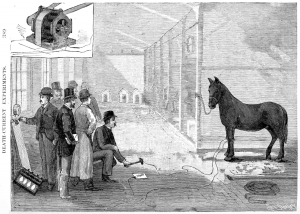
Meanwhile, a murderer was about to be executed in the first electric chair at New York’s Auburn State Prison. Professor Brown had succeeded in illegally purchasing a used Westinghouse generator to demonstrate once and for all the extreme danger of alternating current. The guinea pig was William Kemmler, a convicted ax-murderer, who died horribly on August 6, 1890, in “an awful spectacle, far worse than hanging.” Some newspaper headlines even used the word “Westinghoused” and the technique was later dubbed “Westinghousing.”
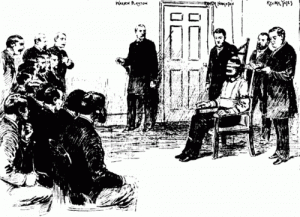
At the beginning of 1893, Westinghouse engineer Benjamin Lamme had made great progress developing an efficient version of Tesla’s induction motor, and Westinghouse Electric started branding their complete polyphase AC system as the “Tesla Polyphase System”. They believed that Tesla’s patents gave them patent priority over other AC systems.
Thomas Edison was waging a relentless campaign to defend his direct current System against Nikola Tesla and his backer Westinghouse Electric. Their final showdown was at one of the largest natural power sources in North America: Niagara Falls.
In 1893, Edward Dean Adams, who headed up the Niagara Falls Cataract Construction Company, sought Tesla’s opinion on which system would be best to transmit power generated at the falls. Over several years, there had been a series of proposals and open competitions on how best to use power generated by the falls. Among the systems proposed by several US and European companies were two-phase and three-phase AC, high-voltage DC, and compressed air. Adams pumped Tesla for information about the current state of all the competing systems. Tesla advised Adams that a two-phased system would be the most reliable and that there was a Westinghouse system to light incandescent bulbs using a two-phase alternating current. The company awarded a contract to Westinghouse Electric to build a two-phase AC generating system at the Niagara Falls, based on Tesla’s advice and Westinghouse’s demonstration at the Columbian Exposition that they could build a complete AC system. At the same time, a further contract was awarded to General Electric to build the AC distribution system. General Electric was the merger of Edison and Thomson-Houston but Edison could never fully accept AC. The board of Edison Electric behind his back decided that AC was the way to go and Edison was forced to see the battle of Niagara falls from the sidelines.
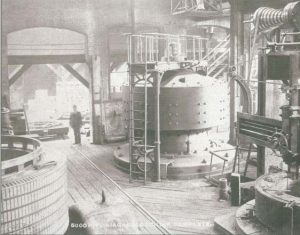
DC commercial power distribution systems declined rapidly in numbers throughout the 20th century, but the last DC system in New York City was shut down in 2007. Today 99.99 percent of all the electricity in this country is generated and distributed using alternating current and that comes down to the ideas and the vision the Tesla had in the late 1880s Tesla’s clearly the winner of the Battle of AC versus DC.
Tesla often said that the only time he was truly happy when he was cooped up in his lab. In the fall of 1937 at the age of 81, after midnight, Tesla left the Hotel New Yorker to make his regular commute to the cathedral and the library to feed the pigeons. While crossing a street a couple of blocks from the hotel, Tesla was unable to dodge a moving taxicab and was thrown to the ground. His back was severely wrenched and three of his ribs were broken in the accident. The full extent of his injuries was never known; Tesla refused to consult a doctor, an almost lifelong custom, and never fully recovered.
On 7 January 1943, at the age of 86, Tesla died alone in Room 3327 of the New Yorker Hotel. His body was later found by maid Alice Monaghan after she had entered Tesla’s room, ignoring the “do not disturb” sign that Tesla had placed on his door two days earlier. Assistant medical examiner H.W. Wembley examined the body and ruled that the cause of death was coronary thrombosis.
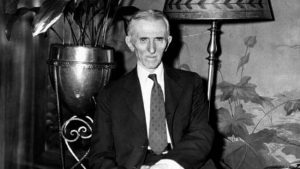
Tesla was a true hero.
“I do not think there is any thrill that can go through the human heart like that felt by the inventor as he sees some creation of the brain unfolding to success. Such emotions make a man forget food, sleep, friends, love, everything”
– Nikola Tesla.
In the end, I don’t want you to go thinking that AC is the only thing you would ever need and DC was just a stepping stone. Most of the modern appliances you would use will rectify AC, converting it into DC before actually using it. So, the sole advantage is in transmission… but, this is also limited and High voltage DC gets better than High voltage AC at higher levels.

If you would like to read more about it, I suggest you go through here.
Or if reading isn’t your thing and you somehow made it to the end, you could watch this guy tell you all about it.
References –
https://en.wikipedia.org/wiki/War_of_the_currents
https://www.forbes.com/sites/alexknapp/2012/05/18/nikola-tesla-wasnt-god-and-thomas-edison-wasnt-the-devil/#26ed73da1a21
https://theoatmeal.com/blog/tesla_response
https://en.wikipedia.org/wiki/Nikola_Tesla
http://www.badassoftheweek.com/tesla.html
http://www.pbs.org/tesla/ll/ll_warcur.html
http://edisontechcenter.org/AC-PowerHistory.html
http://edisontechcenter.org/GalileoFerraris.html#whoInvented



